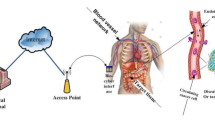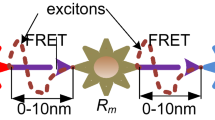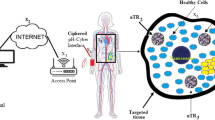Abstract
Nowadays, the Internet of Bio-NanoThings (IoBNT) is playing an important role to become the leading technique used in healthcare delivery systems. The IoBNT is considered a promising paradigm for efficient communication between nanodevices to deliver therapeutic drug molecules and thus achieve the target concentration to the diseased cell/tissue inside intra-body nanonetworks. However, ignoring the physical architecture of these nanodevices may effect on the delivered concentration when employing the IoBNT paradigm. Therefore, in this paper, we propose a spherical transmitter nanodevice, namely reservoir for controlling the drug molecules to be released and showing the effects of the geometry design of such nanodevice on the concentration arrived inside intra-body nanonetwork. Moreover, we present a pharmacokinetic system comprising of a mathematical model for studying the effects and variance in drug concentration, while taking into consideration the distance from the center of the nanotransmitter to the center of the nanoreceiver. The performance analysis of the proposed IoBNT system is numerically investigated. The performance is evaluated by employing the pharmacokinetic model in terms of bio-cyber interface forward and reverse links. The simulation results reveal that the proposed model is able to achieve a high concentration around the targeted cells and thus decrease side effects around healthy cells compared with the state-of-the-art. Additionally, the results illustrate that proposed reservoir is capable of controlling the emission of the therapeutic drug molecules and thus improving the delivery of the dose at target time.











Similar content being viewed by others
References
Chude-Okonkwo, U. A., Malekian, R., & Maharaj, B. S. (2016). Molecular communication model for targeted drug delivery in multiple disease sites with diversely expressed enzymes. IEEE Transactions on Nanobioscience,15(3), 230–245.
Fakruddin, M., Hossain, Z., & Afroz, H. (2012). Prospects and applications of nanobiotechnology: A medical perspective. Journal of Nanobiotechnology,10(1), 31.
Chude-Okonkwo, U. A., Malekian, R., Maharaj, B. et al. Bio-inspired approach for eliminating redundant nanodevices in Internet of Bio-Nano Things, pp. 1–6.
Akyildiz, I. F., Brunetti, F., & Blázquez, C. (2008). Nanonetworks: A new communication paradigm. Computer Networks,52(12), 2260–2279.
Freitas, R. A. (2005). Current status of nanomedicine and medical nanorobotics. Journal of Computational and Theoretical Nanoscience,2(1), 1–25.
Silva, C. O., Pinho, J. O., Lopes, J. M., et al. (2019). Current trends in cancer nanotheranostics: Metallic, polymeric, and lipid-based systems. Pharmaceutics,11(1), 22.
Griffith, L. G., & Naughton, G. (2002). Tissue engineering—Current challenges and expanding opportunities. Science,295(5557), 1009–1014.
Singh, A., Bivalacqua, T. J., & Sopko, N. (2018). Urinary tissue engineering: Challenges and opportunities. Sexual Medicine Reviews,6(1), 35–44.
Gandhi, A., Paul, A., Sen, S. O., et al. (2015). Studies on thermoresponsive polymers: Phase behaviour, drug delivery and biomedical applications. Asian Journal of Pharmaceutical Sciences,10(2), 99–107.
Byrne, R., & Diamond, D. (2006). Chemo/bio-sensor networks. Nature Materials,5(6), 421.
Kuscu, M., & Akan, O. B. Modeling and analysis of SiNW bioFET as molecular antenna for bio-cyber interfaces towards the Internet of Bio-Nanothings, pp. 669–674.
Atakan, B., Akan, O. B., & Balasubramaniam, S. (2012). Body area nanonetworks with molecular communications in nanomedicine. IEEE Communications Magazine,50(1), 28–34.
Nel, A. E., Lutz, M. D., Darrell, V., et al. (2009). Understanding biophysicochemical interactions at the nano-bio interface. Nature Materials,8(7), 543.
Nakano, T., Moore, M., Okaie, Y. et al. Swarming biological nanomachines through molecular communication for targeted drug delivery, pp. 2317–2320.
Nakano, T., Suda, T., Okaie, Y., et al. (2014). Molecular communication among biological nanomachines: A layered architecture and research issues. IEEE Transactions on Nanobioscience,13(3), 169–197.
Yang, W.-W., & Pierstorff, E. (2012). Reservoir-based polymer drug delivery systems. Journal of Laboratory Automation,17(1), 50–58.
Siepmann, J., & Siepmann, F. (2012). Modeling of diffusion controlled drug delivery. Journal of Controlled Release,161(2), 351–362.
Chahibi, Y. (2017). Molecular communication for drug delivery systems: A survey. Nano Communication Networks,11, 90–102.
Chahibi, Y., Akyildiz, I. F., Balasubramaniam, S., et al. (2015). Molecular communication modeling of antibody-mediated drug delivery systems. IEEE Transactions on Biomedical Engineering,62(7), 1683–1695.
Akyildiz, I. F., Pierobon, M., & Balasubramaniam, S. (2019). An information theoretic framework to analyze molecular communication systems based on statistical mechanics. Proceedings of the IEEE,107(7), 1230–1255.
Lanfranco, R., Mognetti, B. M., & Bruylants, G. (2019). Achieving selective targeting using engineered nanomaterials. In Thermodynamics and biophysics of biomedical nanosystems, Springer, pp. 147–182.
Akyildiz, I. F., Pierobon, M., Balasubramaniam, S., et al. (2015). The internet of Bio-Nano Things. IEEE Communications Magazine,53(3), 32–40.
Chude-Okonkwo, U. A., Malekian, R., & Maharaj, B. (2016). Biologically inspired bio-cyber interface architecture and model for Internet of bio-nanothings applications. IEEE Transactions on Communications,64(8), 3444–3455.
AbdEl-atty, S. M., Bidar, R., & El-Rabaie, E. S. M. (2019). MolCom system with downlink/uplink biocyber interface for Internet of Bio-NanoThings. International Journal of Communication Systems,33, e4171.
James, H. P., John, R., Alex, A., et al. (2014). Smart polymers for the controlled delivery of drugs—A concise overview. Acta Pharmaceutica Sinica B,4(2), 120–127.
Torchilin, V. (2009). Multifunctional and stimuli-sensitive pharmaceutical nanocarriers. European Journal of Pharmaceutics and Biopharmaceutics,71(3), 431–444.
Larson, N., & Ghandehari, H. (2012). Polymeric conjugates for drug delivery. Chemistry of Materials,24(5), 840–853.
Dollard, M.-A., & Billard, P. (2003). Whole-cell bacterial sensors for the monitoring of phosphate bioavailability. Journal of Microbiological Methods,55(1), 221–229.
Monson, E., Brasuel, M., Philbert, M., et al. (2003). PEBBLE nanosensors for in vitro bioanalysis. Biomedical Photonics Handbook,9, 1–14.
Dhillon, S., & Kostrzewski, A. (2006). Clinical pharmacokinetics. London: Pharmaceutical Press.
Miah, M. K., Shaik, I. H., Feturi, F. G. et al. (2019). Clinical pharmacokinetics. In Clinical pharmacy education, practice and research, Elsevier, pp. 409–424.
Kuscu, M., Dinc, E., Bilgin, B. A. et al. (2019). Transmitter and receiver architectures for molecular communications: A survey on physical design with modulation, coding, and detection techniques. In Proceedings of the IEEE.
Klein, B. G. (2019). Cunningham’s textbook of veterinary physiology: Elsevier Health Sciences. Amsterdam: Elsevier.
Bourne, D. A. (2018). Mathematical modeling of pharmacokinetic data. Abingdon: Routledge.
Freiberg, S., & Zhu, X. (2004). Polymer microspheres for controlled drug release. International Journal of Pharmaceutics,282(1–2), 1–18.
Hossen, S., Hossain, M. K., Basher, M., et al. (2018). Smart nanocarrier-based drug delivery systems for cancer therapy and toxicity studies: A review. Journal of Advanced Research,15, 1–18.
Cascone, S., Lamberti, G., Titomanlio, G., et al. (2013). Pharmacokinetics of remifentanil: A three-compartmental modeling approach. Translational Medicine@ UniSa,7, 18.
Author information
Authors and Affiliations
Corresponding author
Additional information
Publisher's Note
Springer Nature remains neutral with regard to jurisdictional claims in published maps and institutional affiliations.
Rights and permissions
About this article
Cite this article
El-Fatyany, A., Wang, H. & Abd El-atty, S.M. On mixing reservoir targeted drug delivery Modeling-based Internet of Bio-NanoThings. Wireless Netw 26, 3701–3713 (2020). https://doi.org/10.1007/s11276-020-02294-3
Published:
Issue Date:
DOI: https://doi.org/10.1007/s11276-020-02294-3




